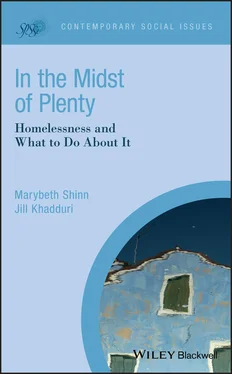Where People Sleep: Definitions of Homelessness
By the late twentieth century, homelessness looked very different from how it appeared to Martin Luther in the sixteenth century or to researchers active between 1900 and 1980. In 1989, sociologist Peter Rossi described “modern” homelessness to distinguish it from earlier phenomena such as transient workers in the Great Depression and skid rows of family‐less working men that were still common as of the 1970s. Rossi distinguished between literal homelessness and precarious housing. Literal homelessness—living on the streets, in a car, in a bus or train station, an encampment of tents or cardboard shacks, or an abandoned building – corresponds to most people's intuitive definitions of homelessness. Europeans call this “living rough.” Rossi added those who sleep in shelters intended for homeless people. People who have access to a conventional home but may not be able to continue to stay there are precariously housed but are not literally homeless. 2 The U.S. Department of Housing and Urban Development (HUD) uses essentially Rossi's definition of literal homelessness, both to determine eligibility for programs that it funds to address homelessness and to estimate how many people are homeless. 3
To limit disruptions in learning that result from precarious housing situations, the U.S. Department of Education takes a more expansive view of what constitutes homelessness to determine eligibility for programs The education definition includes children and youth in families that share housing with other people because of economic hardship (often called doubling up) or who pay to live in hotels or motels because of a lack of alternative accommodations (National Center for Homeless Education, 2017). The more expansive education estimates are reported by school authorities based on answers to questions on a form submitted by parents. In this and other sources of information in the United States, it is difficult to distinguish doubled up situations that are precarious from those that are not.
Europeans have resolved the definitional complexity with a typology that enables the media, policymakers, service providers, and researchers to specify just whom they are talking about, across national borders. The European Typology on Homelessness and Housing Exclusion, with 13 categories and 24 subcategories (European Federation of National Associations Working with the Homeless AISBL, 2017), derives from a conceptual framework that considers a physical domain of housing security (having exclusive possession of an adequate space), a social domain (being able to maintain privacy), and a legal domain (having legal title to occupation). These domains permit consideration of a variety of dimensions of housing insecurity that go beyond literal homelessness, providing that the data exist to support measuring them.
In the U.S., a consensus emerged in the late 1980s that it was useful to know how many people experienced literal homelessness and who they were, in order to design policies to stem the growth of literal homelessness and ultimately end it (Khadduri, 2015). In this book, we follow that consensus, and, when we refer to homelessness, we usually mean literal homelessness in the Rossi and HUD sense. Most research on homelessness refers to some part of this group, typically those who use shelters and other homeless assistance programs, because it is relatively easy to find people in these programs, although there is some information on people who sleep rough—or, in the terminology used in the United States, are “unsheltered.”
Before describing more about the characteristics of people experiencing homelessness, we review the data that inform our descriptions. These data are extensive but not infallible, especially when considered for a particular city.
The Department of HUD mandates communities and organizations that accept HUD funds to keep records in a Homelessness Management Information System (HMIS) and report both numbers and characteristics of people who used homeless shelters and other assistance programs to the federal government. Communities report numbers in categories, not individual records of people or households, for HUD's national accounting. When the data system was first created, there were major concerns about the privacy and safety of vulnerable households, and the decision was made not to create a single, national data system but instead to have communities report aggregate data to HUD and to share data with each other if they wanted to do that.
The best national data come from these local systems, aggregated into the Annual Homeless Assessment Reports to Congress (Henry, Bishop, de Sousa, Shivji, & Watt, 2018; Henry, Mahathey, et al., 2018). An advantage of a community‐wide system is that it allows calculation of the number of people who use some sort of facility over the course of a year and avoids double‐counting of people who use more than one program during that time. Even if all homeless‐serving organizations in a community cooperate in a single system, someone who moves from a shelter in one town to a shelter in another town could be double‐counted. Thirteen states 4 have state‐wide homeless management information systems, either because they are small states with only one planning organization for homelessness or because they have succeeded in merging local systems into a statewide system. People who move across state lines are still missed, as are people who move across communities in many of the larger states.
Entities that do not receive federal funds do not have to report data to the HMIS on people who use their facility, leading to estimates in some communities that are based on weighting up the data that is reported based on the number of beds in these other facilities. In Nashville TN, where Beth lives, only 3% of the beds in emergency shelters were included in 2016, because the Rescue Mission and another large faith‐based provider did not participate. More recently, both providers agreed to cooperate, but because of incompatibility of computer systems, a city staffer had to reenter their data for 2017 by hand.
Gradually, around the country, systems are improving, as communities overcome the technical difficulties implementing information systems and as additional programs without federal funding agree to submit data to local systems. An important reason for the improvement is that many communities use the data for local planning and performance measurement and not just responding to a federal requirement. As of 2017, an estimated 70% of people who used emergency shelters and transitional housing programs 5 were included in HMIS reporting (Henry, Bishop, et al., 2018).
In addition to the required reporting about people who use homeless assistance programs, HUD requires communities to do a point‐in‐time (PIT) count of all people experiencing homelessness, both sheltered and unsheltered, at least every other year, and many communities do one annually. The count happens on a specific night at the end of January, because in cold weather people experiencing homelessness are more likely to sleep indoors, where they are easier to count. But how to count people who are not sleeping in a shelter on that night but instead on the “street?” In most communities, teams of outreach workers and volunteers go to known locations, and ride around in cars in the middle of the night to try to spot and sometimes interview people who are out of doors. However, people experiencing homelessness often have good reasons to remain hidden, and counters are told not to put themselves at risk by searching for them, so such counts are inevitably incomplete.
Together with colleagues, Beth tried to judge just how incomplete the street count was in New York City in 2005 (Hopper, Shinn, Laska, Meisner, & Wanderling, 2008). The City has one of the most sophisticated counts in the country. It divides the entire city into small packets of a few blocks, a transportation hub, or a subway station. It uses the best information available –from police, outreach workers, and previous counts—to estimate whether a homeless person will be found there. It then sends teams of volunteers on foot to all the packets where it expects to find people, and a random sample of the others, in the middle of the night with instructions to interview everyone found there and ascertain whether they are homeless. (People who are sleeping are counted without waking them.) The street count is then the actual number counted in places where people were expected plus a statistical extrapolation from places where they were not.
Читать дальше












